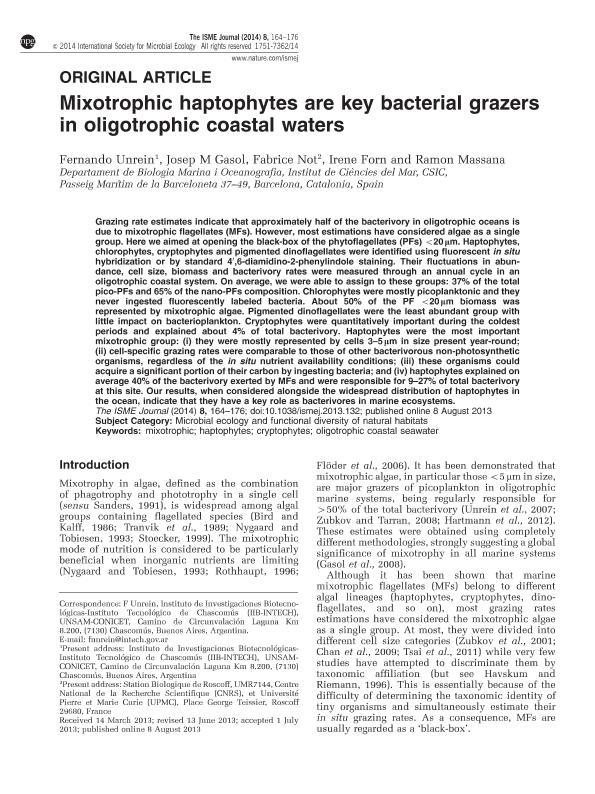Artículo
Mixotrophic haptophytes are key bacterial grazers in oligotrophic coastal waters
Fecha de publicación:
08/08/2013
Editorial:
Nature Publishing Group
Revista:
Isme Journal
ISSN:
1751-7362
Idioma:
Inglés
Tipo de recurso:
Artículo publicado
Clasificación temática:
Resumen
Grazing rate estimates indicate that approximately half of the bacterivory in oligotrophic oceans is due to mixotrophic flagellates. However, most estimations have considered algae as a single group. Here we aimed at opening the black-box of the phytoflagellates (PF) <20 µm. Haptophytes, chlorophytes, cryptophytes and pigmented dinoflagellates were identified using fluorescent in situ hybridization or by standard DAPI-staining. Their fluctuations in abundance, cell-size, biomass, and bacterivory rates were measured through an annual cycle in an oligotrophic coastal system. On average, we were able to assign to these groups 37% of the total pico-phytoflagellates and 65% of the nano-phytoflagellates composition. Chlorophytes were mostly picoplanktonic and they never ingested fluorescently labelled bacteria. About 50% of the PF <20 µm biomass was represented by mixotrophic algae. Pigmented dinoflagellates were the least abundant group with little impact on bacterioplankton. Cryptophytes were quantitatively important during the coldest periods and explained about 4% of total bacterivory. Haptophytes were the most important mixotrophic group: (i) they were mostly represented by cells 3-5 µm in size present year-round; (ii) cell-specific grazing rates were comparable to other bacterivorous non-photosynthetic organisms, regardless of the in situ nutrient availability conditions; (iii) this group could acquire a significant portion of their carbon by ingesting bacteria; and (iv) haptophytes explained on average 40% of the bacterivory exerted by mixotrophic flagellates and were responsible for 9-27% of total bacterivory. Our results, when considered alongside the widespread distribution of haptophytes in the ocean, indicate that they play a key role as bacterivores in marine ecosystems.
Palabras clave:
Mixotrophic
,
Haptophytes
,
Cryptophytes
,
Oligotrophic Coastal Seawater
Archivos asociados
Licencia
Identificadores
Colecciones
Articulos(CCT - LA PLATA)
Articulos de CTRO.CIENTIFICO TECNOL.CONICET - LA PLATA
Articulos de CTRO.CIENTIFICO TECNOL.CONICET - LA PLATA
Articulos(IIB-INTECH)
Articulos de INST.DE INVEST.BIOTECNOLOGICAS - INSTITUTO TECNOLOGICO CHASCOMUS
Articulos de INST.DE INVEST.BIOTECNOLOGICAS - INSTITUTO TECNOLOGICO CHASCOMUS
Citación
Unrein, Fernando; Gasol, Josep M.; Not, Fabrice; Forn, Irene; Massana, Ramon; Mixotrophic haptophytes are key bacterial grazers in oligotrophic coastal waters; Nature Publishing Group; Isme Journal; 8; 8-8-2013; 164-176
Compartir
Altmétricas




